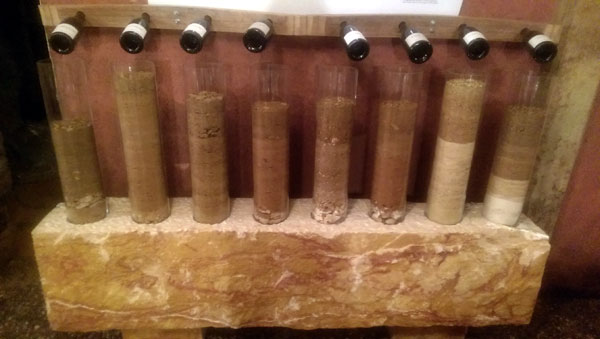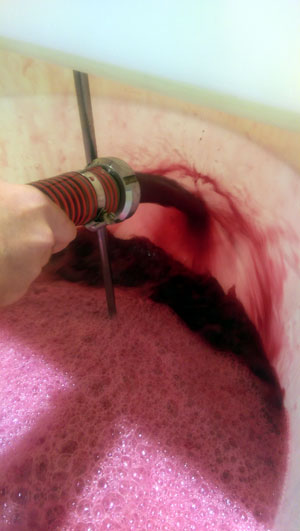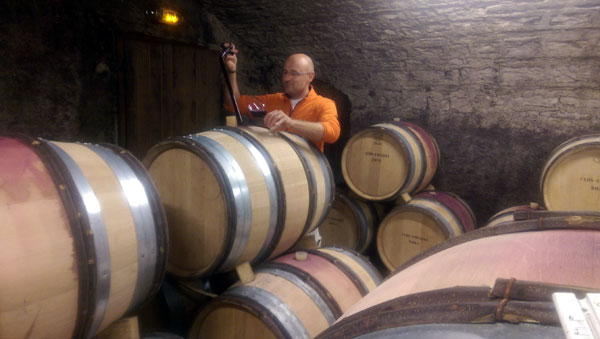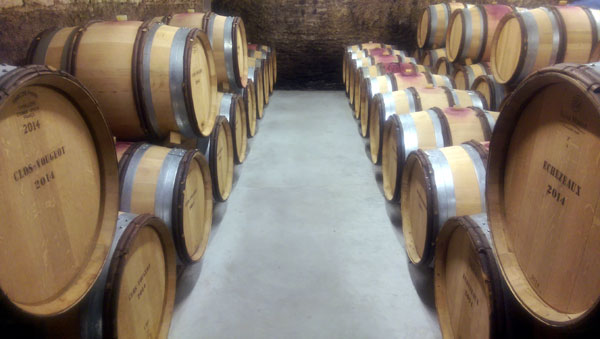After a little break on Sunday with only a short day at the Domaine, we ran a full day of analysis on the wines on Monday, when I was also helping to start pumping over the wines that were releasing their juices in order to promote oxygen contact and feed the yeasts. This was done gently for some cuvees where there is a desire not to add sulphur until after fermentation, but even light pumping over filled the air with the wonderful aromatics of ripe fruit. The colour from the destemmed berries is already a vivid red, with the whole bunch always slower to turn as the juice also flows through the stems, with less direct contact with the skins at first. The “baies par baies” cuvee was the slowest to yield any juice, and it was as much as we could do to get enough liquid for a sample, so slow is the extraction of juice from the berries!

Domaine Mallard's various soils
|
Today was also the day I was able to try something new, by actually crushing the grapes with my feet inside the vats. There are a few things I was glad to have pointed out to me before starting that can make this more difficult than it might seem. One, as the grapes are fermenting they are giving off CO2. The idea is, of course, not to inhale these gasses while pressing the grapes, and avoid collapsing into the ongoing ferment. Lifting the lids a minute or two before getting in greatly aids this process. The second thing, which I didn’t really think of, is that these vats are cold! Chilled to 10 degrees to keep the health of the berries at their best and allow for some cold maceration before the juices really start fermenting, it is rather like taking a knee-deep dip in a fresh water river in the colder months in England. By the time I got out, I was very grateful that one of the team had put a bucket of warm water next to the vat to both clean my legs, and gently bring them back to life! The third thing was removing oneself from the vat, a process which looks easier before you jump in. With the size of the vats, and the process of crushing the grapes meaning you sink ever lower as you do your job, it becomes a bit of a task to get out. Even my 6 foot self was nearly shoulder deep by then end, and hauling myself out proved more difficult and no doubt looked a lot less elegant than I had hoped. Luckily I’m a little taller than the two women working at the Domaine, who have been known to get stuck and need assistance to get out! Still, it is a great thing to have done, and just another connection to the wines in this vintage that mean I simply have to buy these wines once released.

Pumping over the wine. Foam showing the yeasts in action
|
Tuesday was my last day at Domaine d’Eugenie, so Michel invited me to do some more tasting before I left. Firstly, I tasted the wines at his father’s Domaine (Michel Mallard). This Domaine is based in and focuses on wines from the Cote de Beaune. We tasted the 2015s from the vats, which were more advanced than those at Domaine d’Eugenie, having been picked earlier due to the more southern location. They are still very difficult to taste, but the fruit seemed ripe and the sweetness/acid balance good. After that we went down to the cave and saw some of the fermenting whites in the barrels. Merely removing the bungs from the tops led to snap, crackle and pop sounds as the yeasts were clearly in full flow here. Michel and his father have chosen to use more demi-muids (twice the size of a barrique) year on year, as they feel the balance of oak to wine is perfect for white wines. Their size looks impressive, and it is good to see a new technique that allows for a good use of oak that still has restraint. After looking at these, Michel generously let me taste the 2014s in barrel, which will not be released for a couple of years (the Domaine are only now releasing their 2012s). Overall, the structure of these red wines was very impressive. The fruit-acid-tannin balance is fantastic. These won’t be as early drinking as the 2012s, as there is good grip and higher acidity, but the power, spice and ripeness of the fruit is superb. We tasted up through the Ladoix wines to Aloxe Corton, including a delicious 1er Cru Toppe au Vert, and then finally the Grand Cru Cortons. Les Marechaudes was very elegant, floral, and aromatic, with superb, refined tannins and a lifted finish. By contrast, to my palate, the sample of Le Rognet showed darker fruit and a more brooding, spicy character. The wine was focused, intense and long, but will need more time to come around. Finishing with Les Renardes, there was once again a step up in concentration, power and depth to my taste. More structure and rich, ripe fruit with firmer tannins this will be a wine for the long term. Really superb, spicy and aromatically complex. The three different wines all showed different character, and what was really interesting to me was the choice of different tonneliers giving different make-ups to the wines, each bringing their own styles. Michel let me taste Les Renardes barrel by barrel, then a rough estimation of the blend. Though each barrel brought its own merits to the table, and though I had preferences for some over others, it was unquestionable that the blend of all the options resulted in the best wine. Barrels that gave stronger attack and softer fruit complemented others that had length, salinity and structure. Michel is clearly very interested and knowledgeable in how different woods and forests affect the flavour of his wines, and being able to taste and discuss this with him was absolutely fascinating and very enlightening.

Michel extracts some Echezeaux for us to taste
|
On the afternoon of my last day at Domaine d’Eugenie, we went down to the barrel cellar and tasted their 2014s. These are hugely impressive, and the vintage structure of ripe fruit, firm tannins and fresh acidity powered through a long, intense salinity shone through. The village Vosne-Romanée was softer than the other wines, and had real approachability. A lovely ripe red fruit core and soft tannins with a little spice from the wood (not too strong given this was a direct barrel sample) should make superb earlier drinking and offer an insight into the vintage style. The Clos d’Eugenie, despite only being classified as village level, was a clear step up to me. More structure, and more weight of fruit, gave this wine a much longer, riper finish, lifted with a little florality that gave the wine real elegance. After this, the Vosne-Romanée 1er Cru les Brulées, though still in the style of the Domaine with ultra-refined tannins and pure fruit, was aromatically different. The essence of the vineyard shone through, with spicy, smoky undertones and dried herbs providing a real complexity to the fruit. There was a lovely, saline quality that gave this wine real length on the finish. Next up was the Echezeaux, which had another jump in pure fruit power. While still beautifully pure and lifted thanks to the acidity and crunchy tannin, the intensity of floral yet juicy black fruit belied the fleet-footed feel of the wine. Extreme elegance and superb power, this to me was a really fantastic wine and one to watch. It will need time. The Grands Echezeaux, by comparison, was all about elegance. Fresh acidity, red and black fruits, dried flowers and super silky tannins leave a lifted, aromatic finish to this wine. Wonderfully focused and precise, this is very refined, and very well made. The oak touch is already integrating well into the wine, and supports the fruit with some fantastic smoky, savoury spices. Last, but not least, was the Clos de Vougeot. As with the Corton Renardes at Domaine Michel Mallard et Fils, we tasted from several different barrels to see what might be the final blend and how the different components were shaping up. Overall, this looks to be a wine showing both power of black fruits, with lots of spice and plentiful ripe tannins, and elegance of fresh acidity, and persistent floral, aromatic notes. From barrel to barrel the toasting is quite different and gives different aromatic quality and structure, so it will be interesting to see how Michel brings these together into a blend. There is superb fleshiness to the fruit core in all samples however, and the length and ripeness of the fruit looks to hint at another superb wine. Overall the 2014s look to be a really fantastic vintage that will be long lived thanks to their tannin and acid structure supporting the ripe fruit cores. These are however only very young samples before blending, and it will be interesting to taste them once finalised and bottled.

The barrel cellar at Domaine d'Eugenie
|
I left on a drizzly Wednesday morning after one last quick look around the Domaine to say my goodbyes to the team, having gained a lot of knowledge, respect, and admiration for Eugenie and the region as a whole. Visiting Burgundy is the only way to really understand it, and it subtly, quietly and quickly gets under your skin. Since my return I have been drinking an inordinate volume of Chardonnay and Pinot Noir from the Cote d’Or, with no sign of slowing… I can’t wait to go back. I’d like to thank Michel and his whole team for having me, and for being so generous with both their time and wine. It was an extremely enjoyable and enlightening ten days, and a fantastic experience. I’ll be back soon!